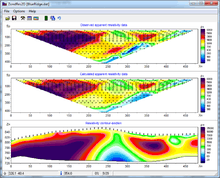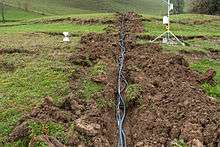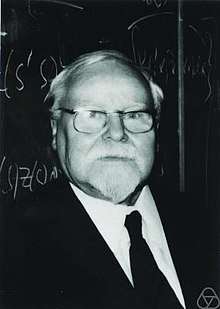Electrical resistivity tomography
Electrical resistivity tomography (ERT) or electrical resistivity imaging (ERI) is a geophysical technique for imaging sub-surface structures from electrical resistivity measurements made at the surface, or by electrodes in one or more boreholes. If the electrodes are suspended in the boreholes, deeper sections can be investigated. It is closely related to the medical imaging technique electrical impedance tomography (EIT), and mathematically is the same inverse problem. In contrast to medical EIT, however, ERT is essentially a direct current method. A related geophysical method, induced polarization (or spectral induced polarization), measures the transient response and aims to determine the subsurface chargeability properties.


History
The technique evolved from techniques of electrical prospecting that predate digital computers, where layers or anomalies were sought rather than images. Early work on the mathematical problem in the 1930s assumed a layered medium (see for example Langer, Slichter). Andrey Nikolayevich Tikhonov who is best known for his work on regularization of inverse problems also worked on this problem. He explains in detail how to solve the ERT problem in a simple case of 2-layered medium. During the 1940s, he collaborated with geophysicists and without the aid of computers they discovered large deposits of copper. As a result, they were awarded a State Prize of Soviet Union.

When adequate computers became widely available, the inverse problem of ERT could be solved numerically. The work of Loke and Barker at Birmingham University was among the first such solution and their approach is still widely used.
With the advancement in the field of Electrical Resistivity Tomography (ERT) from 1D to 2D and now-a- days 3D, ERT has explored many fields. The applications of ERT include fault investigation, ground water table investigation, soil moisture content determination and many others. In industrial process imaging ERT can be used in a similar fashion to medical EIT, to image the distribution of conductivity in mixing vessels and pipes. In this context it is usually called Electrical Resistance Tomography, emphasising the quantity that is measured rather than imaged.
See also
References
- Langer, R. E. (1933-10-01). "An inverse problem in differential equations". Bulletin of the American Mathematical Society. American Mathematical Society (AMS). 39 (10): 814–821. doi:10.1090/s0002-9904-1933-05752-x. ISSN 0002-9904.
- Slichter, L. B. (1933). "The Interpretation of the Resistivity Prospecting Method for Horizontal Structures". Physics. AIP Publishing. 4 (9): 307–322. doi:10.1063/1.1745198. ISSN 0148-6349.
- Langer, R. E. (1936-10-01). "On the determination of earth conductivity from observed surface potentials". Bulletin of the American Mathematical Society. American Mathematical Society (AMS). 42 (10): 747–755. doi:10.1090/s0002-9904-1936-06420-7. ISSN 0002-9904.
- Tikhonov, A. N. (1949). О единственности решения задачи электроразведки. Doklady Akademii Nauk SSSR (in Russian). 69 (6): 797–800.
- A.P. Calderón, On an inverse boundary value problem, in Seminar on Numerical Analysis and its Applications to Continuum Physics, Rio de Janeiro. 1980. Scanned copy of paper
- Loke, M.H. (2004). Tutorial: 2-D and 3-D electrical imaging surveys (PDF). Retrieved 2007-06-11.
- Loke, M.H.; Barker, R.D. (1996). "Rapid least-squares inversion of apparent resistivity pseudosections by a quasi-Newton method". Geophysical Prospecting. Wiley. 44 (1): 131–152. doi:10.1111/j.1365-2478.1996.tb00142.x. ISSN 0016-8025.
- Loke, M.H.; Barker, R.D. (1996). "Practical techniques for 3D resistivity surveys and data inversion". Geophysical Prospecting. Wiley. 44 (3): 499–523. doi:10.1111/j.1365-2478.1996.tb00162.x. ISSN 0016-8025.